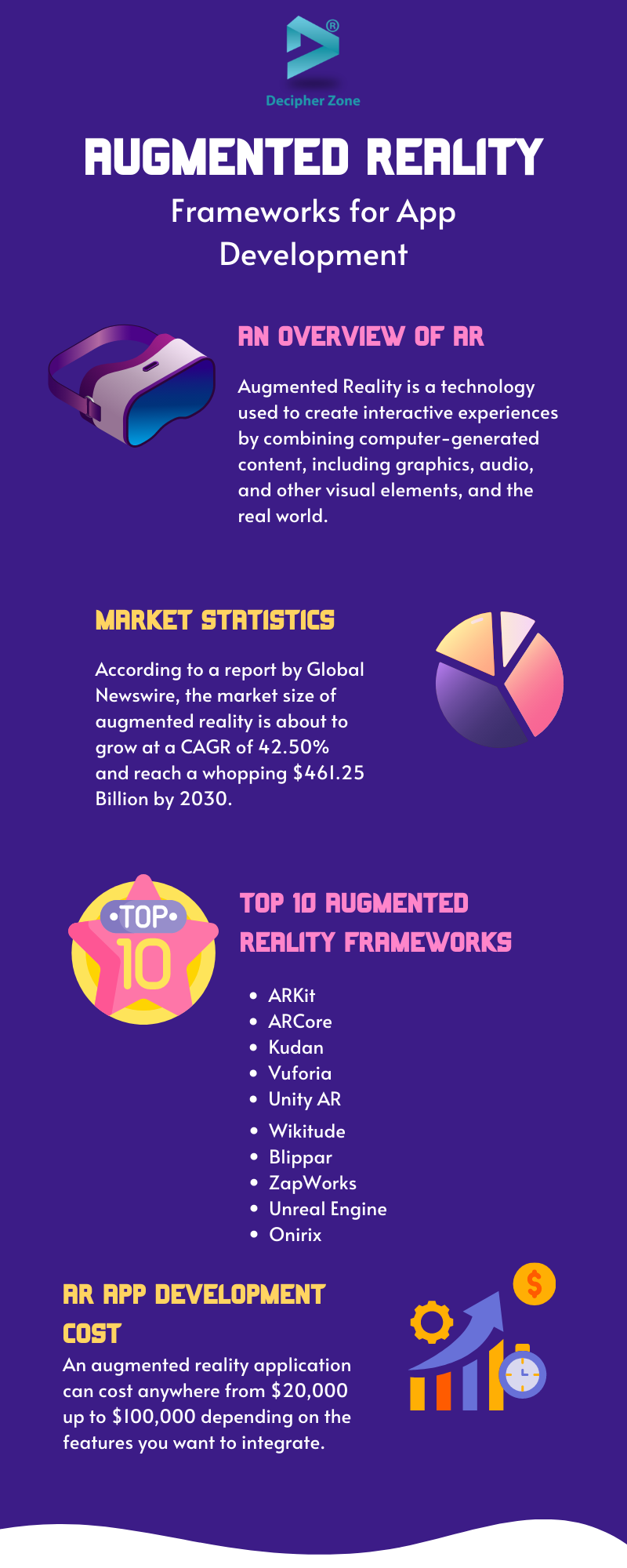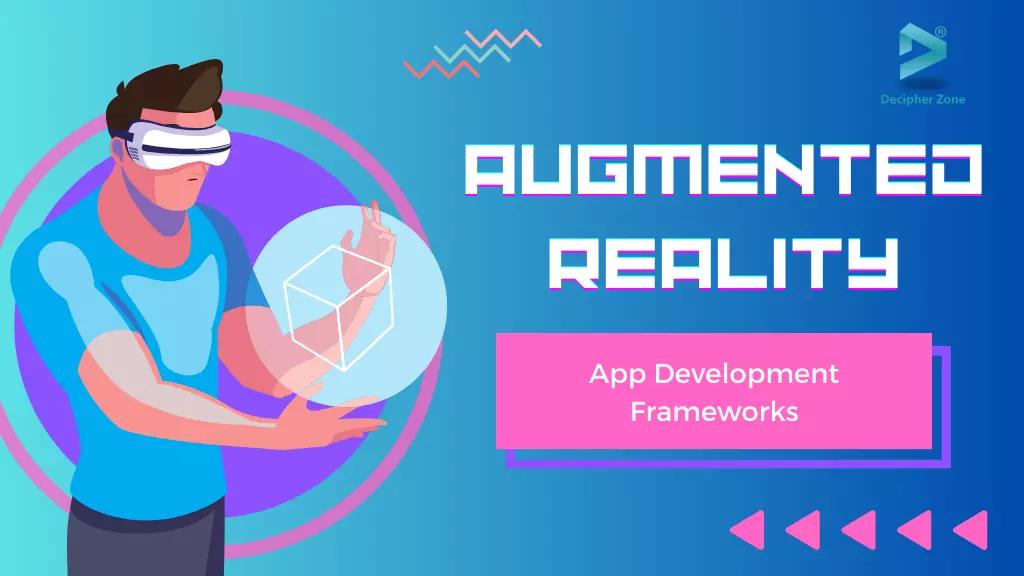Augmented Reality - Definition, Importance of AR for Businesses, and Top 10 Best AR frameworks for App Development in 2023.
Since the late 1980s, several movies such as They Live, Terminator, Iron Man, and Avatar have shown us what life with Augmented Reality might look like. But what we saw in sci-fi movies is now becoming a reality.
Today, Augmented Reality or AR is one of the crucial technologies empowering digital transformation in the real world. AR allows businesses to offer an immersive and interactive experience for the user by stimulating computer-generated elements into the user’s environment.
In fact, according to a report by Global Newswire, the market size of augmented reality is about to grow at a CAGR of 42.50% and reach a whopping $461.25 Billion by 2030.
That being said, in this blog, we will cover what augmented reality is, how it can be beneficial for your business, and what are the top augmented reality frameworks that you should consider while developing an AR application.
So, here we go!
What is Augmented Reality?
Augmented Reality is a technology used to create interactive experiences by combining computer-generated content, including graphics, audio, and other visual elements, and the real world.
Read: What is Automation
AR consists of three basic features - overlaid sensory information, a combination of 3D virtual objects, real-time interaction, real world, and virtual world. Unlike virtual reality which aims to create an artificial environment, augmented reality allows its users to experience generated visual information overlaid on top of the real world.
One of the most popular examples of augmented reality is Nintendo’s Pokémon Go and Snapchat.
Pokémon Go is a game where players walk in the real world to watch the Pokémon characters appear on the game map and once they are close enough Pokémon appear on their device screen so the users can capture them by throwing Poké balls.
On the other hand, Snapchat is a multimedia instant messaging app that overlays a filter over the snaps/pictures of the user that they can instantly share with their friends.
Businesses can use augmented reality to showcase demo products, enhance brand awareness, streamline workflow, increase revenue, and improve customer experience. Some of the top industries for which augmented reality can be ideal are Healthcare, Entertainment, Gaming, Manufacturing, Real Estate, Automotive, Travel, Social Media, and the Military.
Top 10 Augmented Reality Frameworks for App Development in 2023
Here is the list of top 10 best Augmented Reality Frameworks for App Development in 2023.
-
ARKit
-
Kudan
-
ARCore
-
Vuforia
-
Unity’s AR Foundation
-
Wikitude
-
Blippar
-
ZapWorks
-
Unreal Engine
-
Onirix
Now that we have a better understanding of augmented reality, it’s time we move on to the main topic of the blog - augmented reality frameworks.
But before that let's get a brief introduction to frameworks.
Frameworks are built on top of a programming language that acts as a basic structure with pre-written components, interfaces, and tools to build software applications.
And some of the top augmented reality frameworks that you should know about before hiring developers to create an AR-based application are:
1. ARKit
Developed by Apple, ARKit is a software development framework that allows developers to create AR-based applications for iOS devices. It combines the device’s camera scene capture, motion tracking, display accessibilities, and advanced scene processing, making it easier to detect the orientation and position of the device in the real world and overlay generated content on top of the camera view.
2. Kudan
It is a free SDK engine written in C++ that combines Simultaneous Localization and Mapping (SLAM) to provide sensory power to devices for understanding motion and environment. Kudan is especially known for its ability and speed to recognize objects. It also has APIs for native platforms such as Java for Android and Objective C for iOS.
3. ARCore
Developed by Google, ARCore is an augmented reality SDK that offers APIs for cross-platform application development. It is capable of creating immersive experiences for iOS, Web, Unity, and Android. Motion tracking, environmental understanding, light estimation, depth understanding, oriented points, user interactions, etc. are some of the fundamental tools ARCore provides to create AR experiences for the user.
4. Vuforia
Vuforia augmented reality engine lets you develop experiences to transform the way to sell and market the business product. It uses vision technology that can recognize and track 3D images as well as flat ones in real-time. The core focus of Vuforia is working towards the advantage of manufacturing, sales, and frontline workers.
5. Unity’s AR Foundation
Developed by Unity, AR Foundation is the framework built for creating rich AR experiences that can be deployed across wearable AR devices as well as mobiles. The core features of AR Foundation are curated from Magic Leap, HoloLens, ARKit, and ARCore. Some of the functionalities that the AR Foundation offer are plane tracking, device tracking, anchors, light estimation, environment understanding, face tracking, point clouds, raycast, meshing, and session management.

6. Wikitude
It is an all-in-one AR framework with a cross-platform toolkit for iOS, Unity, and Android. Wikitude offers an intuitive 3D interface on which you can work without using any programming skills.
7. Blippar
It is an AR browser that uses mobile devices’ cameras to recognize real-world objects and images and then overlay digital content above them. Blippar has an AR Creator/Developer tool called BlippBuilder that allows you to simply drag-and-drop interfaces to build an augmented reality for AR headsets and smartphones.
8. ZapWorks
It is an all-in-one web AR platform with no-code, low-code, and custom code options that strengthens marketers, designers, and developers to create alluring WebAR experiences.
9. Unreal Engine
It is a robust AR framework that provides unified experiences for Android and iOS devices. It is free and cost-effective until you earn significant profits. Unreal Engine AR can perform texturing, animation, 3D Modeling, and VFX.
10. Onirix
Another popular augmented reality platform used by creators to build webAR for eCommerce businesses, games, catalogs, etc., and improve the user experience.
Augmented Reality Application Development Cost
An augmented reality application can cost anywhere from $20,000 up to $100,000 depending on the features you want to integrate.
If you are also thinking about developing an AR-based app, make sure to hire experienced AR developers with relevant skills from companies like Decipher Zone.
Conclusion
Undoubtedly, augmented reality is going to be a part of our daily life sooner than we expected. To keep up with the constantly evolving technology, it is a must to digitalize your business. And one of the best ways to achieve that is by investing in AR-based application development.
FAQs About Augmented Reality App Development Frameworks
What is an AR framework?
An AR framework similar to any other software development framework is an abstraction or skeletal structure that serves as a support for creating an application.
What technologies are used in augmented reality?
Optical sensors, digital cameras, RFID (Radio Frequency Identification), accelerometers, and holography are some of the technologies used in augmented reality.
What are the top 10 augmented reality frameworks?
ARKit, Kudan, ARCore, Vuforia, Unity AR, Wikitude, Blippar, ZapWorks, Unreal Engine, and Onirix are the top 10 AR frameworks you can go for.

